Gondwana Rainforests facts for kids
| UNESCO World Heritage Site | |
|---|---|
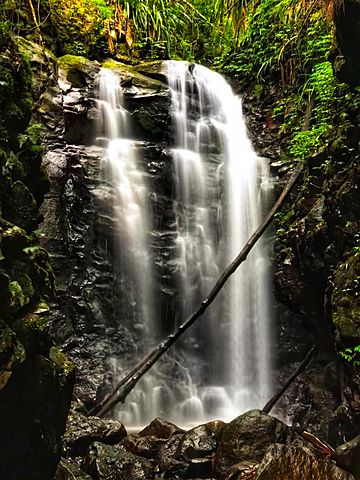
Box Log Falls, Lamington National Park in Queensland
|
|
| Location | New South Wales and Queensland, Australia |
| Criteria | Natural: (viii), (ix), (x) |
| Inscription | 1986 (10th Session) |
| Extensions | 1994 |
| Area | 370,000 ha (1,400 sq mi) |
| Official name | Gondwana Rainforests of Australia |
| Type | National heritage (landscape) |
| Designated | 17 December 1994 |
| Reference no. | 105135 |
| Class | Natural |
| Legal Status | Declared property |
| Official name | Gondwana Rainforests of Australia; Central Eastern Rainforest Reserves; Gondwana Rainforests of Australia (new name from 2007); North East Rainforests World Heritage Area |
| Type | State heritage (landscape) |
| Designated | 2 April 1999 |
| Reference no. | 1002 |
| Type | Wilderness |
| Category | Landscape – Natural |
The Gondwana Rainforests of Australia, formerly known as the Central Eastern Rainforest Reserves, are the most extensive area of subtropical rainforest in the world. Collectively, the rainforests are a World Heritage Site with fifty separate reserves totalling 366,500 hectares (906,000 acres) from Newcastle to Brisbane.
Contents
Background
The Gondwana Rainforests are so-named because the fossil record indicates that when Gondwana existed it was covered by rainforests containing the same kinds of species that are living today. Not all Gondwanan rainforests in Australia are located in the New South Wales – Queensland region; the largest Gondwanan rainforest in Australia is located in Tasmania's Tarkine wilderness. The number of visitors to the Gondwana rainforest reserves in New South Wales and Queensland is about 2 million per year.
The World Heritage status of the region was created and negotiated initially in 1986, with the area extended in 1994, following a nomination which was prepared in 1992 by the Rainforest Conservation Society. The World Heritage listing carries the following inscription:
The Gondwana Rainforests of Australia is a serial property comprising the major remaining areas of rainforest in southeast Queensland and northeast New South Wales. It represents outstanding examples of major stages of the Earth’s evolutionary history, ongoing geological and biological processes, and exceptional biological diversity. A wide range of plant and animal lineages and communities with ancient origins in Gondwana, many of which are restricted largely or entirely to the Gondwana Rainforests, survive in this collection of reserves. The Gondwana Rainforests also provides the principal habitat for many threatened species of plants and animals.
– Brief synthesis of the Gondwana Rainforests of Australia as inscribed on the UNESCO World Heritage List.
The site was gazetted on the Australian National Heritage List on 21 May 2007 under the ; and the New South Wales portion was added to the New South Wales State Heritage Register on 2 April 1999.
Conservation value
The forests were inscribed to the World Heritage list in 1986, covering only the New South Wales sites of approximately 310,800 hectares (768,000 acres) and extended in 1994 to cover the Queensland sites of approximately 59,200 hectares (146,000 acres) which is a total of approximately 370,000 hectares (910,000 acres). The rainforest reserves have an extremely high conservation value, with more than 200 rare or threatened plant and animal species.
Eight separate areas have been identified as having outstanding heritage significance to Australia and are included on the Australian National Heritage List. The altitude of the reserves ranges from sea level to almost 1,600 m (5,200 ft).
On 22 December 2000, the High Conservation Value Old Growth forest covering 24 national parks and 19 nature reserves spread across 12 local government areas in the upper north east region of New South Wales were listed on the New South Wales State Heritage Register.
National parks
The Queensland areas include the Main Range, at its most northern point; and extending south, the Lamington, Mount Chinghee, Springbrook and Mount Barney national parks.
The New South Wales areas include the Barrington Tops, at its most southern point; and extending north, the Dorrigo, Mount Warning, New England, Mebbin, Nightcap, Border Ranges, Oxley Wild Rivers, Washpool, Willi Willi and Werrikimbe national parks.
The most heavily visited parts are Dorrigo National Park and the Natural Bridge section of Springbrook National Park.
Destruction
The region was historically logged extremely heavily, to such an extent that only 1% of the original range of the Gondwana rainforest remains in Australia. Most of the logged regions have been taken over by eucalyptus forest.
During the 2019-2020 Australian bushfire season, many regions of the Gondwana rainforest were devastated by bushfires for the first time, with some preliminary reports indicating that up to 53% of the forests may have burned as of January 2020. Among the devastated habitats are several locations that are significant for some critically imperiled species, such as the nightcap oak and the giant barred frog. The presence of these devastating blazes in areas that have never burned before has been linked to the encroachment of the flammable eucalyptus trees into the logged areas adjoining the forests. The general claim of "never burned before" has been challenged by several commentators, based on an article in The Cairns Post on 25 October 1951 that reported a "fire has burnt out about 2000 acres of thick rainforest country" in the Lamington National Park.
Australian National Heritage List sections
The Gondwana Rainforests of Australia are divided into sections for listing on the Australian National Heritage List, from north to south, as below:
| Section | Park or reserve name | State | Image | Area | Coordinates | Source(s) | |
|---|---|---|---|---|---|---|---|
| km2 | sq mi | ||||||
| Main Range group; near Killarney |
Acacia Plateau Flora Reserve | NSW | |||||
| Emu Vale State Forest (part) | Qld | ||||||
| Gambubal State Forest (part) | Qld | ||||||
| Gilbert State Forest (part) | Qld | ||||||
| Goomburra State Forest (part) | Qld | ||||||
| Main Range National Park | Qld | 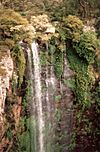 |
184 | 71 | 27°48′57″S 152°15′56″E / 27.81583°S 152.26556°E | ||
| Spicers Gap Road Conservation Park | Qld |  |
28°04′35″S 152°23′26″E / 28.07639°S 152.39056°E | ||||
| Spicers Gap State Forest (part) | Qld | ||||||
| Teviot State Forest (part) | Qld | ||||||
| Wilsons Peak Flora Reserve | NSW |  |
28°15′19″S 152°29′21″E / 28.25528°S 152.48917°E | ||||
| Focal Peak group; on the NSW–Qld border |
Burnett Creek State Forest (part) | ||||||
| Captains Creek Flora Reserve (part) | |||||||
| Mallanganee National Park | NSW | 11 | 4.2 | 25°55′09″S 152°45′13″E / 25.91917°S 152.75361°E | |||
| Mount Clunie National Park (part) | NSW | 14 | 5.4 | 28°19′27″S 152°31′12″E / 28.32417°S 152.52000°E | |||
| Mount Nothofagus National Park (part) | NSW | 22 | 8.5 | 28°19′02″S 152°38′01″E / 28.31722°S 152.63361°E | |||
| Tooloom National Park (part) | NSW | 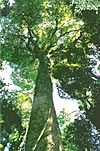 |
44 | 17 | 28°26′47″S 152°27′13″E / 28.44639°S 152.45361°E | ||
| Toonumbar National Park (part) | NSW |  |
149 | 58 | 28°29′16″S 152°43′33″E / 28.48778°S 152.72583°E | ||
| Shield Volcano group; on the NSW–Qld border on the McPherson and Tweed ranges |
Amaroo Flora Reserve | ||||||
| Border Ranges National Park (part) | NSW |  |
317 | 122 | 28°21′35″S 152°59′10″E / 28.35972°S 152.98611°E | ||
| Lamington National Park | Qld |  |
206 | 80 | 28°8′32″S 153°6′55″E / 28.14222°S 153.11528°E | ||
| Limpinwood Nature Reserve | NSW | 26.5 | 10.2 | 28°17′56″S 153°10′26″E / 28.29889°S 153.17389°E | |||
| Mebbin National Park (part) | |||||||
| Mount Chinghee National Park |  |
||||||
| Nightcap National Park (part) | |||||||
| Numinbah Nature Reserve | NSW | 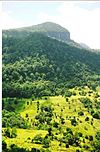 |
8.6 | 3.3 | 28°15′S 153°16′E / 28.250°S 153.267°E | ||
| Springbrook National Park (part) | Qld |  |
62 | 24 | 28°08′24″S 153°16′27″E / 28.14000°S 153.27417°E | ||
| various Rabbit Board Reserves along the Rabbit Board fence |
|||||||
| Wollumbin National Park | NSW | 24 | 9.3 | 28°23′23″S 153°16′7″E / 28.38972°S 153.26861°E | |||
| Coastal group; on the coast at Iluka |
Iluka Nature Reserve | NSW | 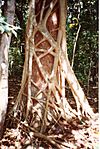 |
1.35 | 0.52 | 29°24′14″S 153°21′44″E / 29.40389°S 153.36222°E | |
| Washpool and Gibraltar Range group; contiguous areas between Glen Innes and Grafton |
Gibraltar Range National Park | NSW | |||||
| Washpool National Park | NSW | ||||||
| New England group; near Dorrigo |
Cunnawarra National Park (part) | NSW | |||||
| Dorrigo National Park (part) | NSW | ||||||
| Mount Hyland Nature Reserve (part) | NSW |  |
25 | 9.7 | 30°9′36″S 152°26′42″E / 30.16000°S 152.44500°E | ||
| New England National Park (part) | NSW | 673 | 260 | 30°35′34″S 152°27′30″E / 30.59278°S 152.45833°E | |||
| Hastings–Macleay group; southeast of Armidale |
Fenwicks Scrub Flora Reserve | NSW |  |
1.1 | 0.42 | 31°17′S 152°8.8′E / 31.283°S 152.1467°E | |
| Mount Seaview Nature Reserve | NSW | ||||||
| Oxley Wild Rivers National Park (part) | NSW |  |
1,452 | 561 | 30°59′47″S 152°00′36″E / 30.99639°S 152.01000°E | ||
| The Castles Flora Reserve | NSW | 30°59′55″S 152°20′5″E / 30.99861°S 152.33472°E | |||||
| Werrikimbe National Park (part) | NSW |  |
333 | 129 | 31°12′S 152°14′E / 31.200°S 152.233°E | ||
| Willi Willi National Park (part) | NSW | 299 | 115 | 31°10′43″S 152°29′27″E / 31.17861°S 152.49083°E | |||
| Barrington Tops group; north of Dungog |
Barrington Tops National Park (part) | NSW | 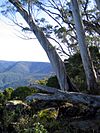 |
765 | 295 | 32°3′10″S 151°29′37″E / 32.05278°S 151.49361°E | |
| Mount Royal National Park (part) | NSW |  |
69 | 27 | 32°12′1″S 151°19′25″E / 32.20028°S 151.32361°E | ||
See also
 In Spanish: Bosques húmedos Gondwana de Australia para niños
In Spanish: Bosques húmedos Gondwana de Australia para niños
- Environment of Australia
- Forests of Australia
- List of World Heritage Sites in Australia
- Mount Banda Banda
- Rainforest Way, a tourist drive featuring the Gondwana rainforests of south-eastern Queensland and north-eastern New South Wales

